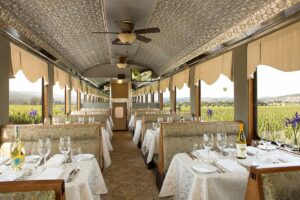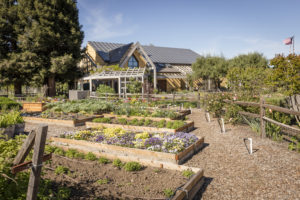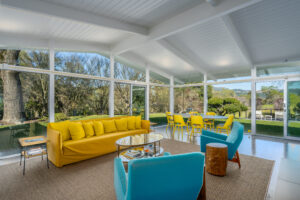Native to the Rhone Valley of Southern France, Rhone grapes were introduced to California during the mid-19th century and likely arrived in Sonoma County around the 1880s. Today, these grapes are known as Rhone varieties and the wines produced from them are called Rhone-varietal wines.
There are 22 Rhone varieties in France (or 24, depending on who you ask), with 14 now grown in the United States thanks to the extensive work of wineries like Tablas Creek in Paso Robles. You may be familiar with syrah, grenache and viognier, but there are so many more to explore.
Produced in a kaleidoscope of colors, textures and characters, with verve that can seamlessly surpass other wines, Rhone varietal wines can offer a refreshing change of pace for wine drinkers seeking something new. Check out these recommendations for some of the best places to sample Rhone wines in Sonoma County.
Frick Winery
Perched among the wildflowers on a hillside overlooking Dry Creek Valley, Frick Winery’s tiny tasting room is an intimate gem among its grander neighbors, with just enough space for four guests at a time.
Winemaker and proprietor Bill Frick has been making Rhone varietal wines since 1976. Today, he continues that legacy as a soft-spoken, one-man show, acting as winemaker, vineyard manager, harvester, barrel washer and tasting room host all rolled into one.
A highlight of Frick Winery is its estate-grown, single-varietal expressions of carignane, mourvèdre, viognier and cinsaut — the latter which is produced from 65-year-old vines that live on the 7.7-acre property surrounding the tasting room. Frick’s blends are also outstanding. Tastings are free (it’s true). Open 11 a.m. to 4:30 p.m. Saturday and Sunday, with the addition of Fridays in late spring; reservations required.
23072 Walling Road, Geyserville, 707-484-3950, frickwinestore.com
Quivira Vineyards & Winery
Dry Creek Valley and France’s southern Rhone Valley have similar terroir, and nowhere is that more evident than at Quivira Vineyards & Winery.
Here, in the outskirts of Healdsburg, the warm to hot days and cool nights are highly conducive to growing Rhone varieties like grenache, which Quivira began planting over 20 years ago. With great emphasis on biodiversity, land preservation and renewable energy, the winery produces numerous Rhone varietal wines, including a luscious rousanne viognier blend from its biodynamic, organic vineyards.
A visit here is a true retreat, especially during spring and summer when the vibrant garden is in full bloom. Tastings from $30. Open 10:30 a.m. to 4:30 p.m., Thursday to Monday; reservations required.
4900 West Dry Creek Road, Healdsburg, 707-431-8333, quivirawine.com
Two Shepherds
“Winemaking is an art, not a science,” said William Allen, winemaker and proprietor of Windsor’s Two Shepherds winery, where he produces small-lot Rhone varietal wines with minimal intervention.
What started as a garagiste hobby in 2010 has bloomed into a 3,200-case endeavor, with a focus on unusual grapes sourced from cool-climate or old-vine vineyards. Native yeast fermentation, neutral oak and minimal sulfur are integral to Allen’s winemaking process, which he performs on about 15 petite lots per year. Needless to say, this makes for an intriguing, educational tasting experience in his small warehouse tasting room.
Don’t miss the newly released 2019 Carignan, which hails from 75-year-old, dry-farmed vines. Tastings from $20, waived with one bottle per person purchase. Open noon to 5 p.m. Thursday to Saturday.
7763 Bell Road, Windsor, 415-613-5731, twoshepherds.com
Jeff Cohn Cellars
Think you know GSM? Think again at Jeff Cohn Cellars in Healdsburg Plaza, where the classic southern Rhone trio of grenache, syrah and mourvèdre has been transformed into a Tavel-inspired (a southern Rhone Valley winegrowing region) brut rosé that is buoyant with bubbles.
With a deep passion for the wines of Châteauneuf-du-Pape, Jeff Cohn (the former winemaker at Rosenblum Cellars) has been making Rhone varietal wines since 2006, which he sells alongside his “Rhone-centric zinfandel.” Syrahs are a big focus here (there are four available), along with mourvèdre, grenache and other Rhone varieties sourced from rocky, mineral-driven vineyards.
Wine tastings at Jeff Cohn Cellars start with red wines and end with whites, which shines a well-deserved spotlight on Cohn’s single-varietal marsanne, viognier and grenache blanc rousanne blend. Tastings from $30. Open 11 a.m. to 6 p.m. Friday to Sunday; reservations recommended.
34 North St., Healdsburg, 707-938-8343, jeffcohncellars.com
Bedrock Wine Co.
There are few places in California where you can taste wines produced from some of the oldest, most historic vineyards in the state. That’s the intrigue of a visit to Bedrock Wine Company in Sonoma, where winemaker and owner Morgan Twain-Peterson produces character-driven wines from vines that are more than 100 years old.
While he never planned on opening a tasting room, Twain-Peterson changed his mind once General Joseph Hooker’s historic 1852 home came up for rent in Sonoma Plaza. Twain-Peterson owned Hooker’s 150-year-old vineyard, so serving wines from the general’s vineyards under the roof of his former home was kismet.
Today, you can sample Bedrock’s deeply structured carignane, mourvèdre, zinfandel and other varieties from Hooker’s 132-year-old vines, along with syrah, petite sirah and heritage blends from historic vineyards throughout California. Tastings from $30. Open 10:30 a.m. to 4:30 p.m. Thursday to Sunday; reservations required.
General Joseph Hooker House, 414 First St. East, Sonoma, 707-343-1478, bedrockwineco.com
Pax Wines
Thanks to the mindful hands of winemakers like Pax Mahle, syrah from California finally found its groove.
Evolving past the powerful, commanding style that once gained him notoriety, Mahle now focuses on leaner, more nuanced expressions of the northern Rhone varietal. With fruit sourced from cool-climate vineyards as far north as the Mendocino coast, he makes wine using native yeast fermentation and minimal intervention.
In his laid-back Sebastopol Barlow tasting room, you can sample Mahle’s stellar lineup of syrahs, grenache mourvèdre rosé, chenin blanc and more. Local cheese plates and charcuterie are also available, as well as live music from 4:30 to 6:30 p.m. every Friday. Tastings from $25. Open 11 a.m. to 6 p.m. Sunday to Thursday, 11 a.m. to 7 p.m. Friday and Saturday.
6780 McKinley St., Sebastopol. 707-331-1393, paxmahlewines.com













